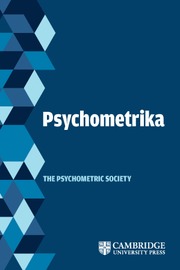Crossref Citations
This article has been cited by the following publications. This list is generated based on data provided by
Crossref.
Brams, Steven J.
1968.
Measuring the Concentration of Power in Political Systems.
American Political Science Review,
Vol. 62,
Issue. 2,
p.
461.
Clark, Herbert H.
1968.
On the use and meaning of prepositions.
Journal of Verbal Learning and Verbal Behavior,
Vol. 7,
Issue. 2,
p.
421.
Levelt, W. J. M.
1969.
The scaling of syntactic relatedness: A new method in psycholinguistic research.
Psychonomic Science,
Vol. 17,
Issue. 6,
p.
351.
Turner, Malcolm E.
1969.
CREDIBILITY AND CLUSTER.
Annals of the New York Academy of Sciences,
Vol. 161,
Issue. 2,
p.
680.
Miller, George A.
1969.
A psychological method to investigate verbal concepts.
Journal of Mathematical Psychology,
Vol. 6,
Issue. 2,
p.
169.
Hosono, Kimio
1969.
Automatic classification technique for document retrieval.
Library and Information Science,
Vol. 7,
Issue. ,
p.
117.
Green, Paul E.
and
Rao, Vithala R.
1969.
A Note on Proximity Measures and Cluster Analysis.
Journal of Marketing Research,
Vol. 6,
Issue. 3,
p.
359.
Henley, Nancy M.
1969.
A psychological study of the semantics of animal terms.
Journal of Verbal Learning and Verbal Behavior,
Vol. 8,
Issue. 2,
p.
176.
Burton, Michael L.
1970.
Computer applications in cultural anthropology.
Computers and the Humanities,
Vol. 5,
Issue. 1,
p.
37.
McZgee, Victor E.
and
Carleton, Willard T.
1970.
Piecewise Regression.
Journal of the American Statistical Association,
Vol. 65,
Issue. 331,
p.
1109.
Degerman, Richard
1970.
Multidimensional Analysis of Complex Structure: Mixtures of Class and Quantitative Variation.
Psychometrika,
Vol. 35,
Issue. 4,
p.
475.
Kintsch, Walter
1970.
Models of Human Memory.
p.
331.
Levelti, W. J. M.
1970.
Hierarchial chunking in sentence processing.
Perception & Psychophysics,
Vol. 8,
Issue. 2,
p.
99.
MacKay, C. K.
and
Brown, W. P.
1970.
Metaphor Preference vs. Semantic Ratings as Measures of Attitude Toward Time.
The Journal of General Psychology,
Vol. 83,
Issue. 2,
p.
207.
Vogel, Peter H.
1970.
A basis for technological forecasting.
Technological Forecasting,
Vol. 1,
Issue. 3,
p.
313.
1970.
Cognitive Development.
p.
204.
Anderson, M.
and
Benning, R.
1970.
A distribution-free discrimination procedure based on clustering.
IEEE Transactions on Information Theory,
Vol. 16,
Issue. 5,
p.
541.
Brams, Steven J.
and
O'Leary, Michael K.
1970.
An Axiomatic Model of Voting Bodies.
American Political Science Review,
Vol. 64,
Issue. 2,
p.
449.
Clark, Herbert H.
and
Begun, Jeffrey S.
1971.
The Semantics of Sentence Subjects.
Language and Speech,
Vol. 14,
Issue. 1,
p.
34.
1971.
Computer program abstracts.
Behavioral Science,
Vol. 16,
Issue. 4,
p.
411.

